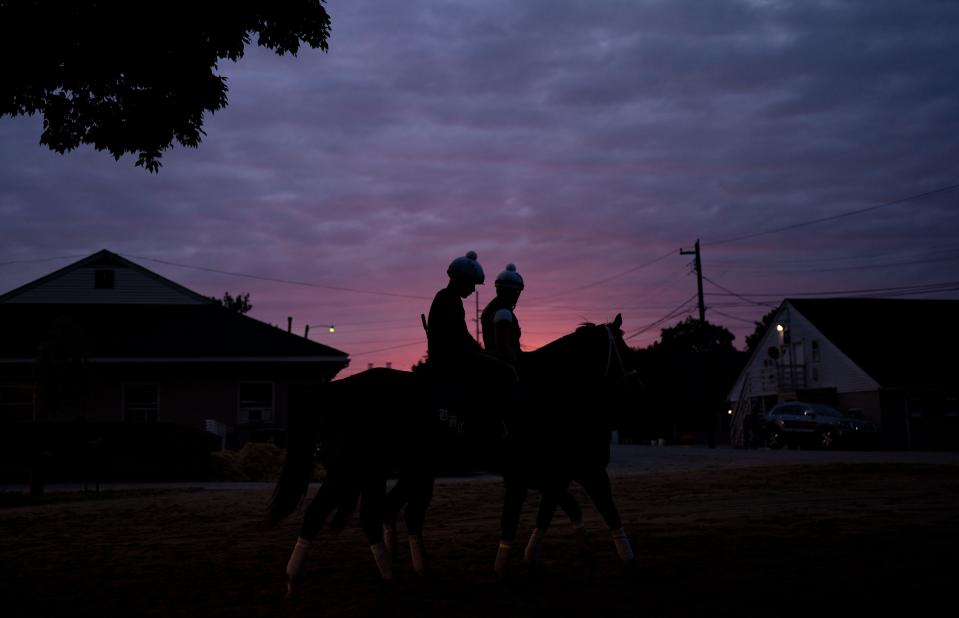Brown: Horse racing is at crossroads — it needs national standards and these new measures
New measures that went into effect Monday with the intent of establishing a national standard for equine safety are not being met with open arms within the horse racing industry, even as headlines from the sport's biggest events are marred by mentions of death.
Seven horses died in 10 days at Churchill Downs leading up to the Kentucky Derby, including two on race day. Think that didn’t affect interest? According to Nielsen Ratings, it was the least watched Kentucky Derby across all viewing platforms since 2011 — not counting 2020 when the COVID-19 pandemic forced the race to be moved to September.
Bob Baffert couldn’t even fully celebrate his triumphant return to the Triple Crown trail Saturday in the Preakness Stakes. The Hall of Fame trainer got emotional after National Treasure’s win because one of his other horses, Havnameltdown, had to be euthanized earlier in the day after a prior race at Pimlico Race Course. On that same day, Churchill Downs announced a ninth death in the past month.
The horse racing industry is at a crossroads. It can either embrace changes or expect to fall apart.
'Overkill' or status quo? Recent horse racing deaths cast shadow before Preakness Stakes
Bob Baffert: Trainer mourns horse's death as he considers National Treasure's status for Belmont

The Horseracing Integrity and Safety Authority (HISA) was signed into law by former President Donald Trump in 2020 and charged with making horse racing safer in two areas. The racetrack safety component began last July.
That alone has not prevented deaths. But it was notable as National Treasure and Blazing Sevens battled down the stretch of the Preakness in how few times their jockeys struck them. The new safety rules limit use of a whip to six strikes after the first furlong.
The second component, the Anti-Doping and Medication Control (ADMC) program, was supposed to begin at the same time as racetrack safety. It faced several delays before finally going into effect on Monday.
This could be the game-changer for horse racing.
The ADMC program brings drug testing — with an emphasis on out-of-competition tests and not just post-race — under the same umbrella. No longer will there be different standards of substances and screening levels for different states and, in some cases, different tracks in the same state.
There needs to be one standard for all 38 racing states. And that’s what it appears Congressman Andy Barr from Kentucky’s District 6 was aiming for when he began co-sponsoring versions of the legislation that established HISA beginning in 2015.
Troubling trend continues: Ninth horse death at Churchill Downs in past month
C.L. Brown: Horse safety at Churchill Downs starts with addressing people problem during Derby week
There are signs that added scrutiny could inject the changes that are needed. Only seven horses ran the Preakness, which was the smallest field since 1986, after the Brad Cox-trained First Mission scratched.
First Mission was the second choice with 5-2 odds in the morning line behind Kentucky Derby winner Mage, who had 8-5 odds. Forte was the favorite to win the Kentucky Derby until a race-day scratch. First Mission and Forte were taken out of races due to an abundance of caution given the rash of injuries and deaths.
Churchill Downs suspended trainer Saffie Joseph Jr. and the Kentucky Horse Racing Commission forced him to scratch his remaining three horses from competing after two of his horses collapsed and died after racing. That included his Kentucky Derby hopeful Lord Miles, who Joseph had planned to run because the colt did not have any contact with the two who died.
The implementation of HISA will take some pressure off trainers to have injured horses compete. The ADMC bans medication within 24 hours of a race, so conceivably horses that shouldn't be racing, won't be just because they took a shot to disguise pain.
Serious challenges await the sustainability of HISA as a governing body.
Since the law establishing HISA was passed by Congress in December 2020, there's already been a lot of litigation over its legitimacy. The Fifth Circuit Court of Appeals ruled the original legislation unconstitutional, forcing Congress to amend it in December 2022 to give additional oversight to the Federal Trade Commission over HISA.
More on Saffie Joseph: Lord Miles scratched from Kentucky Derby after deaths; Churchill Downs suspends trainer
With the amended language included, a U.S. District judge in Texas ruled this month that it is constitutional. But there are indications from National Horsemen's Benevolent and Protective Association (HBPA) and other plaintiffs that the battle isn’t over.
It may be years before it's finally settled. National HBPA president Eric Hamelback said in a statement after the loss that, “We will fight to protect horsemen and their constitutional rights all the way to the Supreme Court if needed.”
What’s needed is someone to fight for the horses.
HISA brings that.
There’s too much of a distraction over who is being given power here and not enough focus on what HISA is trying to establish. Horse racing needs uniformity and transparency.
HISA brings that.
So the horse racing industry should either allow HISA to bring it, or sit back and watch the sport decline into oblivion.
Reach sports columnist C.L. Brown at clbrown1@gannett.com and follow him on Twitter at @CLBrownHoops.
This article originally appeared on Louisville Courier Journal: Horse deaths: Why HISA Anti-Doping And Medication Control is positive

